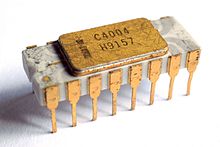
Back إنتل 4004 Arabic Intel 4004 Azerbaijani Intel 4004 Bulgarian ইন্টেল ৪০০৪ Bengali/Bangla Intel 4004 Catalan Intel 4004 Czech Intel 4004 German Intel 4004 Greek Intel 4004 Esperanto Intel 4004 Spanish
 Intel C4004 processor with grey traces | |
| General information | |
|---|---|
| Launched | November 15, 1971 |
| Discontinued | 1981[1] |
| Marketed by | Intel |
| Designed by | Intel |
| Common manufacturer(s) |
|
| Performance | |
| Max. CPU clock rate | 740 KHz to 750 KHz |
| Data width | 4 bits |
| Address width | 12 bits (multiplexed) |
| Architecture and classification | |
| Application | Busicom calculator, arithmetic manipulation |
| Technology node | 10 μm |
| Instruction set | 4-bit BCD-oriented |
| Physical specifications | |
| Transistors |
|
| Package(s) |
|
| Socket(s) | |
| History | |
| Successor(s) | Intel 8008 (8-bit) Intel 4040 (4-bit) |
| Support status | |
| Unsupported | |
The Intel 4004 is a 4-bit central processing unit (CPU) released by Intel Corporation in 1971. Sold for US$60 (equivalent to $450 in 2023[2]), it was the first commercially produced microprocessor,[3] and the first in a long line of Intel CPUs.
The 4004 was the first significant example of large-scale integration, showcasing the superiority of the MOS silicon gate technology (SGT). Compared to the incumbent technology, the SGT integrated on the same chip area twice the number of transistors with five times the operating speed. This step-function increase in performance made possible a single-chip CPU, replacing the existing multi-chip CPUs. The innovative 4004 chip design served as a model on how to use the SGT for complex logic and memory circuits, thus accelerating the adoption of the SGT by the world's semiconductor industry. The developer of the original SGT at Fairchild was Federico Faggin, who designed the first commercial integrated circuit (IC) that used the new technology, proving its superiority for analog/digital applications (Fairchild 3708 in 1968). He later used the SGT at Intel to obtain the unprecedented integration necessary to make the 4004.
The project traces its history to 1969, when Busicom Corp. approached Intel to design a family of seven chips for an electronic calculator, three of which constituted a CPU specialized for making different calculating machines. The CPU was based on data stored on shift-registers and instructions stored on ROM (read only memory). The complexity of the three-chip CPU logic design led Marcian Hoff to propose a more conventional CPU architecture based on data stored on RAM (random-access memory). This architecture was much simpler and more general-purpose and could potentially be integrated into a single chip, thus reducing the cost and improving the speed. Design began in April 1970 under the direction of Faggin, aided by Masatoshi Shima, who contributed to the architecture and later to the logic design. The first delivery of a fully operational 4004 was in March 1971 to Busicom for its 141-PF printing calculator engineering prototype (now displayed in the Computer History Museum in Mountain View, California).[4] General sales began July 1971.
A number of innovations developed by Faggin while working at Fairchild Semiconductor allowed the 4004 to be produced on a single chip. The main concept was the use of the self-aligned gate, made of polysilicon rather than metal, which allowed the components to be much closer together and work at higher speed. To make the 4004 possible, Faggin also developed the "bootstrap load", considered unfeasible with silicon gate, and the "buried contact" that allowed the silicon gates to be connected directly to the source and drain of the transistors without the use of metal. Together, these innovations doubled the circuit density, and thus halved cost, allowing a single chip to contain 2,300 transistors and run five times faster than designs using the previous MOS technology with aluminum gates.
The 4004 design was later improved by Faggin as the Intel 4040 in 1974. The Intel 8008 and 8080 were unrelated designs in spite of the similar naming.
- ^ "The Life Cycle of a CPU". www.cpushack.com.
- ^ "The 40th birthday of—maybe—the first microprocessor, the Intel 4004". 2011-11-15.
- ^ "The Story of the Intel 4004". Intel.
- ^ "The Intel 4004 Microprocessor and the Silicon Gate Technology: The Busicom Engineering Prototype". Intel4004.com.
© MMXXIII Rich X Search. We shall prevail. All rights reserved. Rich X Search